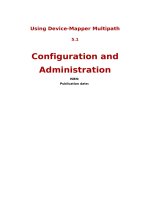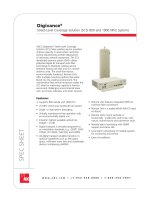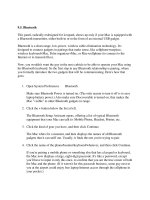Tài liệu IPv6 pptx
Bạn đang xem bản rút gọn của tài liệu. Xem và tải ngay bản đầy đủ của tài liệu tại đây (872.21 KB, 32 trang )
IPv6
CCNA Exploration version 4.0
Học viện mạng Cisco Bách Khoa - Website:
www.ciscobachkhoa.com
2
Overview
•
IP version 6 (IPv6) was developed to overcome the limitations of the
current standard, IP version 4 (IPv4). IPv4 allows end systems to
communicate and forms the foundation of the Internet as we know it
today. However, one of the major shortcomings of IPv4 is its limited
amount of address space. The explosion of new IP-enabled devices
and the growth of undeveloped regions have fueled the need for more
addresses.
•
In the United States, the Department of Defense (DoD) is a primary
driver for the adoption of IPv6.
Học viện mạng Cisco Bách Khoa - Website:
www.ciscobachkhoa.com
3
Introducing IPv6
•
IP version 6 (IPv6) combines expanded addressing with a
more efficient and feature-rich header to meet the demands
for scalable networks in the future.
•
One key benefit is that IPv6 can recreate end-to-end
communications without the need for Network Address
Translation (NAT)
•
Cisco Systems currently supports IPv6 in Cisco IOS
Software Release 12.2(2)T and later.
Học viện mạng Cisco Bách Khoa - Website:
www.ciscobachkhoa.com
4
IPv6 Features
Học viện mạng Cisco Bách Khoa - Website:
www.ciscobachkhoa.com
5
Large Address Space
Học viện mạng Cisco Bách Khoa - Website:
www.ciscobachkhoa.com
6
•
IPv6 routers do not perform fragmentation. Instead, a
discovery process determines the optimum maximum
transmission unit (MTU) to use during a given session.
•
Link-layer technologies already perform checksum and error
control. Because link-layer technologies are relatively
reliable, an IP header checksum is considered to be
redundant.
Học viện mạng Cisco Bách Khoa - Website:
www.ciscobachkhoa.com
7
Comparing IPv4 and IPv6 Headers
•
Flow Label: 20-bit field that allows a particular flow of traffic to be labeled. It
can be used for multilayer switching techniques and faster packet-switching
performance.
•
Extension Headers: Follows the previous eight fields. The number of
extension headers is not fixed, so the total length of the extension header
chain is variable.
Traffic class: ToS
Payload Length
Next Header: Tcp, Udp…
Hop Limit: TTL
No Checksum
Học viện mạng Cisco Bách Khoa - Website:
www.ciscobachkhoa.com
8
Extension Header
Extension Header
Học viện mạng Cisco Bách Khoa - Website:
www.ciscobachkhoa.com
9
IPv6 Extension Headers
•
IPv6 Header: Basic header described in the previous figure.
•
Hop-by-hop options header
•
Destination options header (when the routing header is used)
•
Routing header: Used for source routing and mobile IPv6 (value =
43).
•
Fragment header: Used when a source must fragment a packet that is
larger than the MTU for the path between itself and a destination
device.
•
Authentication header and Encapsulating Security Payload
header: Used within IPsec to provide authentication, integrity, and
confidentiality of a packet. The authentication header (value = 51) and
the ESP header (value = 50)
•
Upper-layer header: Typical headers used inside a packet to transport
the data. The two main transport protocols are TCP (value = 6) and
UDP (value = 17).
Học viện mạng Cisco Bách Khoa - Website:
www.ciscobachkhoa.com
10
Defining Address Representation
•
Leading zeros in a field are optional, so 09C0 = 9C0 and 0000 = 0.
•
Successive fields of zeros can be represented as “::” only once in an
address.
•
An unspecified address is written as “::” because it contains only zeros.
Học viện mạng Cisco Bách Khoa - Website:
www.ciscobachkhoa.com
11
IPv6 Address types
•
Unicast address
–
Link local: FE80::/10, Scope is configured to single link. The
address is unique only on this link, and it is not routable off the link.
(similar to 169.254.x.x private address)
–
Site local: FEC0::/10 (similar to private address)
–
Global: Globally unique, so it can be routed globally with no
modification. A global address has an unlimited scope on the
worldwide Internet. Packets with global source and destination
addresses are routed to their target destination by the routers on
the Internet.
•
Multicast address: IPv6 does not have broadcast addresses. The
range of multicast addresses in IPv6 is larger than in IPv4. For the
foreseeable future, allocation of multicast groups is not being limited.
•
Anycast address: An anycast address identifies a list of devices or
nodes; therefore, an anycast address identifies multiple interfaces. A
packet sent to an anycast address is delivered to the closest interface,
as defined by the routing protocols in use.
Học viện mạng Cisco Bách Khoa - Website:
www.ciscobachkhoa.com
12
Special Address









